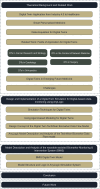A comprehensive review of digital twin in healthcare in the scope of simulative health-monitoring
- PMID: 39777066
- PMCID: PMC11705329
- DOI: 10.1177/20552076241304078
A comprehensive review of digital twin in healthcare in the scope of simulative health-monitoring
Abstract
Objective: Digital twins (DTs) emerged in the wake of Industry 4.0 and the creation of cyber-physical systems, motivated by the increased availability and variability of machine and sensor data. DTs are a concept to create a digital representation of a physical entity and imitate its behavior, while feeding real-world data to the digital counterpart, thus allowing enabling digital simulations related to the real-world entity. The availability of new data sources raises the potential for developing structured approaches for prediction and analysis. Similarly, in the field of medicine and digital healthcare, the collection of patient-focused data is rising. Medical DTs, a new concept of structured, exchangeable representations of knowledge, are increasingly used for capturing personal health, targeting specific illnesses, or addressing complex healthcare scenarios in hospitals.
Methods: This article surveys the current state-of-the-art in applying DTs in healthcare, and how these twins are generated to support smart, personalized medicine. These concepts are applied to a DT for a simulated health-monitoring scenario.
Results: The DT use case is implemented using AnyLogic multi-agent simulation, monitoring the patient's personal health indicators and their development.
Conclusion: The results indicate both possibilities and challenges and provide important insights for future DT implementations in healthcare. They have the potential to optimize healthcare in various ways, such as providing patient-centered health-monitoring.
Keywords: Digital twin; health-monitoring; healthcare; personalized medicine; simulation.
© The Author(s) 2025.
Conflict of interest statement
The author(s) declared no potential conflicts of interest with respect to the research, authorship, and/or publication of this article.
Figures









Similar articles
-
Concepts and applications of digital twins in healthcare and medicine.Patterns (N Y). 2024 Aug 9;5(8):101028. doi: 10.1016/j.patter.2024.101028. eCollection 2024 Aug 9. Patterns (N Y). 2024. PMID: 39233690 Free PMC article. Review.
-
Digital Twins for Clinical and Operational Decision-Making: Scoping Review.J Med Internet Res. 2025 Jan 8;27:e55015. doi: 10.2196/55015. J Med Internet Res. 2025. PMID: 39778199 Free PMC article.
-
Lung-DT: An AI-Powered Digital Twin Framework for Thoracic Health Monitoring and Diagnosis.Sensors (Basel). 2024 Feb 1;24(3):958. doi: 10.3390/s24030958. Sensors (Basel). 2024. PMID: 38339678 Free PMC article.
-
Digital Twins for More Precise and Personalized Treatment.Stud Health Technol Inform. 2024 Jan 25;310:229-233. doi: 10.3233/SHTI230961. Stud Health Technol Inform. 2024. PMID: 38269799
-
Digital Twins' Advancements and Applications in Healthcare, Towards Precision Medicine.J Pers Med. 2024 Nov 11;14(11):1101. doi: 10.3390/jpm14111101. J Pers Med. 2024. PMID: 39590593 Free PMC article. Review.
Cited by
-
From data-driven cities to data-driven tumors: dynamic digital twins for adaptive oncology.Front Artif Intell. 2025 Jul 25;8:1624877. doi: 10.3389/frai.2025.1624877. eCollection 2025. Front Artif Intell. 2025. PMID: 40785836 Free PMC article. No abstract available.
References
-
- Kaul R, Ossai C, Forkan ARM, et al.. The role of AI for developing digital twins in healthcare: the case of cancer care. WIREs Data Min Knowl Discov 2023; 13.
-
- Sittner S, Schuldt J, Gröger S. Digital q-twin: Interoperabilität qualitätsbezogener Daten auf Basis des digitalen Zwilling. In: Woll R and Goldmann C (eds) Trends und Entwicklungstendenzen im Qualitätsmanagement. Wiesbaden: Springer Fachmedien, 2022, pp.83–94.
LinkOut - more resources
Full Text Sources

